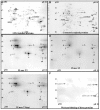Selection and identification of proteins bound to DNA triple-helical structures by combination of 2D-electrophoresis and MALDI-TOF mass spectrometry
- PMID: 11376162
- PMCID: PMC55697
- DOI: 10.1093/nar/29.11.2427
Selection and identification of proteins bound to DNA triple-helical structures by combination of 2D-electrophoresis and MALDI-TOF mass spectrometry
Abstract
Identification of proteins binding specifically to peculiar nucleic acid structures can lead to comprehension of their role in vivo and contribute to the discovery of structure-related gene regulation. This work was devoted to establishing a reliable procedure to select proteins on the basis of their interaction with a nucleic acid probe chosen to fold into a given structure. 2D-electrophoresis and mass spectrometry were combined for protein identification. We applied this procedure to select and identify triplex-binding activities in HeLa nuclear extracts. To achieve this, we used a panel of deoxyribonucleic probes adopting intramolecular triple-helices, varying in their primary sequence, structure or triple-helix motif. A limited number of spots was reproducibly revealed by South-western blotting. Spots of interest were localised among a complex population of (35)S-labelled proteins according to their (32)P-specific emission. Position of the same spots was extrapolated on a preparative gel coloured with Coomassie blue, allowing excision and purification of the corresponding proteins. The material was subjected to mass spectrometry upon trypsin digestion and MALDI-TOF peptide fingerprinting was used for research in databases: five of them were identified and found to belong to the hnRNP family (K, L, A2/B1, E1 and I). The identities of several of them were confirmed by comparing western and South-western blots on the same membrane using specific antibodies. The recognition specificity of most of these proteins is large, according to previous reports and our own experiments. It includes pyrimidine-rich DNA sequences in different contexts: single strand to a small extent, triplex and possibly other higher-order structures.
Figures




Similar articles
-
Two-dimensional electrophoresis and mass spectrometry identification of proteins bound by a murine monoclonal anti-cardiolipin antibody: a powerful technique to characterize the cross-reactivity of a single autoantibody.Electrophoresis. 2000 Jul;21(12):2531-9. doi: 10.1002/1522-2683(20000701)21:12<2531::AID-ELPS2531>3.0.CO;2-E. Electrophoresis. 2000. PMID: 10939468
-
Identification of apoptosis-associated proteins in a human Burkitt lymphoma cell line. Cleavage of heterogeneous nuclear ribonucleoprotein A1 by caspase 3.J Biol Chem. 1998 Oct 23;273(43):28057-64. doi: 10.1074/jbc.273.43.28057. J Biol Chem. 1998. PMID: 9774422
-
Heterogeneous nuclear ribonucleoprotein A3 binds single-stranded telomeric DNA and inhibits telomerase extension in vitro.Biochim Biophys Acta. 2008 Feb;1783(2):193-202. doi: 10.1016/j.bbamcr.2007.08.006. Epub 2007 Sep 4. Biochim Biophys Acta. 2008. PMID: 17919748
-
Direct on-membrane peptide mass fingerprinting with MALDI-MS of tyrosine-phosphorylated proteins detected by immunostaining.J Chromatogr B Analyt Technol Biomed Life Sci. 2007 Feb 15;847(1):24-9. doi: 10.1016/j.jchromb.2006.08.024. Epub 2006 Sep 7. J Chromatogr B Analyt Technol Biomed Life Sci. 2007. PMID: 16959554 Review.
-
MALDI-TOF-MS analysis of protein and DNA.Neuroscientist. 2001 Feb;7(1):6-12. doi: 10.1177/107385840100700104. Neuroscientist. 2001. PMID: 11486345 Review.
Cited by
-
Triple helix-interacting proteins and cancer.OA Mol Oncol. 2013 Apr 1;1(1):5. doi: 10.13172/2052-9635-1-1-708. OA Mol Oncol. 2013. PMID: 24910779 Free PMC article.
-
Identification of the SRC pyrimidine-binding protein (SPy) as hnRNP K: implications in the regulation of SRC1A transcription.Nucleic Acids Res. 2003 Mar 1;31(5):1502-13. doi: 10.1093/nar/gkg246. Nucleic Acids Res. 2003. PMID: 12595559 Free PMC article.
-
Analytical biochemistry of DNA--protein assemblies from crude cell extracts.Nucleic Acids Res. 2007;35(13):e92. doi: 10.1093/nar/gkm490. Epub 2007 Jul 7. Nucleic Acids Res. 2007. PMID: 17617645 Free PMC article.
-
N-(1-naphthyl) ethylenediamine dinitrate: a new matrix for negative ion MALDI-TOF MS analysis of small molecules.J Am Soc Mass Spectrom. 2012 Sep;23(9):1454-60. doi: 10.1007/s13361-012-0421-z. Epub 2012 Jun 19. J Am Soc Mass Spectrom. 2012. PMID: 22711516
-
Associations between intronic non-B DNA structures and exon skipping.Nucleic Acids Res. 2014 Jan;42(2):739-47. doi: 10.1093/nar/gkt939. Epub 2013 Oct 22. Nucleic Acids Res. 2014. PMID: 24153112 Free PMC article.
References
-
- Mirkin S.M. and Frank-Kamenetskii,M.D. (1994) H-DNA and related structures. Annu. Rev. Biophys. Biomol. Struct., 23, 541–576. - PubMed
-
- Hampel K.J., Ashley,C. and Lee,J.S. (1994) Kilobase-range communication between polypurine.polypyrimidine tracts in linear plasmids mediated by triplex formation: a braided knot between two linear duplexes. Biochemistry, 33, 5674–5681. - PubMed
-
- Musso M., Nelson,L.D. and Van Dyke,M.W. (1998) Characterization of purine-motif triplex DNA-binding proteins in HeLa extracts. Biochemistry, 37, 3086–3095. - PubMed
-
- Guieysse A.L., Praseuth,D. and Hélène,C. (1997) Identification of a triplex DNA-binding protein from human cells. J. Mol. Biol., 267, 289–298. - PubMed
Publication types
MeSH terms
Substances
LinkOut - more resources
Full Text Sources
Other Literature Sources

